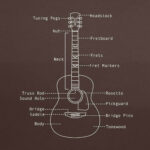The world of guitars and basses can sometimes be a confusing place, especially when instruments blur the lines between categories. One such instrument is the Fender Bass VI, a fascinating creation that has sparked debate and intrigue among musicians since its inception. Often referred to as a Fender 6 String Bass Guitar, it’s crucial to understand that this instrument is indeed a bass guitar, and not a baritone guitar, despite some common misconceptions.
To truly appreciate the Fender 6 string bass guitar, and specifically the Bass VI, it’s important to distinguish it from its close cousin, the baritone guitar. While both venture into lower tonal territories than standard guitars, they are fundamentally different instruments with distinct purposes and designs.
Understanding the Fender Bass VI: A True Six-String Bass
The Fender Bass VI, in both its vintage and modern forms offered by Fender and Squier, is unequivocally a bass guitar. This classification isn’t just a matter of branding; it’s rooted in the instrument’s construction and intended function. Key characteristics define the Bass VI as a member of the bass family:
- Bass Guitar Strings: The most immediate indicator is the strings. The Bass VI is strung with bass guitar strings, albeit a specialized set designed for its unique scale length and tuning. These strings are heavier gauge than those found on baritone guitars, contributing to its bass-like sonic character.
- Shorter Bass Scale Length: With a 30-inch scale length, the Bass VI aligns with short-scale bass guitars. This is significantly longer than the typical baritone guitar scale length of around 27 inches. This longer scale is crucial for achieving proper tension and intonation when tuned an octave below a standard guitar.
- Bass Tuning: The Fender 6 string bass guitar utilizes standard guitar tuning (EADGBE), but crucially, it’s pitched one octave lower. This tuning is the same as a standard four-string bass guitar with two additional higher strings. This low tuning is the core of its bass identity, allowing it to occupy the bass frequency range in a band or recording.
The concept of using alternate tunings on a Bass VI is possible, but it doesn’t transform it into a baritone guitar. Similarly, attempting to use bass strings on a baritone guitar is impractical due to the shorter scale length, which would result in excessively floppy and unusable strings. The hardware, including tuners, is also designed for lighter gauge guitar strings on baritone guitars, further highlighting the incompatibility.
Baritone Guitars: Exploring the Lower Registers of Guitar
Baritone guitars, in contrast, are firmly in the guitar family. They are designed to extend the tonal range of a guitar downwards, offering a deeper voice without venturing fully into bass territory. Key traits of baritone guitars include:
- Guitar Strings: Baritone guitars use guitar strings, though typically heavier gauges than standard guitars to accommodate lower tunings. They are not designed for the much heavier strings of a bass guitar.
- Longer Guitar Scale Length: Baritone guitars typically feature a scale length around 27 inches. This scale length is longer than standard guitars but shorter than even short-scale basses, placing them squarely between the two instrument categories.
- Lower Guitar Tunings: Baritone guitars are most commonly tuned a fourth lower than standard guitar tuning (BEADF#B). This tuning places the lowest string at the same pitch as the low E string on a standard guitar, but the overall range is shifted downwards. Other tunings like a fifth lower (ADGCEA) or a major third lower (CFBbEbGC) are also used, further exploring lower registers while maintaining a guitaristic character.
Fender themselves have produced true baritone guitars, such as the Sub-Sonic Baritone Stratocaster, Jaguar Baritone Special HH, and Blacktop Telecaster Baritone, always explicitly labeling them as “baritone guitars.” These models consistently feature the 27-inch scale length characteristic of baritone instruments.
Why the Confusion?
The confusion between the Fender 6 string bass guitar and baritone guitars likely stems from their shared characteristic of occupying a lower tonal range than standard guitars. Both instruments venture into territories that can be described as “deeper” or “lower.” However, the crucial distinction lies in their fundamental design, tuning, and intended sonic roles. The Bass VI is designed to function as a bass, providing the low-end foundation in music, while the baritone guitar expands the guitar’s sonic palette downwards, offering a richer, deeper guitar voice.
Embracing the Unique Voice of the Fender 6 String Bass Guitar
The Fender 6 string bass guitar, or Bass VI, is not simply a hybrid instrument; it’s a unique voice in the musical landscape. It offers a distinctive sonic palette that sits between a traditional bass and a guitar, making it a versatile tool for musicians seeking new textures and tones. Whether you’re aiming for deep, resonant bass lines or exploring unique chord voicings in a lower register, the Fender Bass VI provides a compelling and inspiring musical experience.
To delve deeper into the world of guitar knowledge and techniques, explore resources like Fender Play’s informative videos. Continuous learning and exploration are key to unlocking the full potential of any instrument, especially one as unique and intriguing as the Fender 6 string bass guitar.

